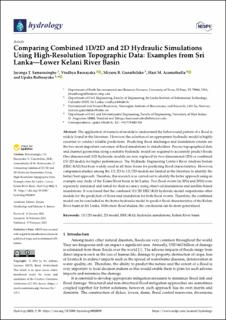| dc.contributor.author | Samarasinghe, Jayanga T. | |
| dc.contributor.author | Basnayaka, Vindhya | |
| dc.contributor.author | Gunathilake, Miyuru | |
| dc.contributor.author | Azamathulla, Hazi M. | |
| dc.contributor.author | Rathnayake, Upaka | |
| dc.date.accessioned | 2022-10-11T08:23:25Z | |
| dc.date.available | 2022-10-11T08:23:25Z | |
| dc.date.created | 2022-04-25T10:08:17Z | |
| dc.date.issued | 2022-02-17 | |
| dc.identifier.citation | Hydrology. 2022, 9 (2), 1-17. | en_US |
| dc.identifier.issn | 2306-5338 | |
| dc.identifier.uri | https://hdl.handle.net/11250/3025295 | |
| dc.description.abstract | The application of numerical models to understand the behavioural pattern of a flood is widely found in the literature. However, the selection of an appropriate hydraulic model is highly essential to conduct reliable predictions. Predicting flood discharges and inundation extents are the two most important outcomes of flood simulations to stakeholders. Precise topographical data and channel geometries along a suitable hydraulic model are required to accurately predict floods. One-dimensional (1D) hydraulic models are now replaced by two-dimensional (2D) or combined 1D/2D models for higher performances. The Hydraulic Engineering Centre’s River Analysis System (HEC-RAS) has been widely used in all three forms for predicting flood characteristics. However, comparison studies among the 1D, 2D to 1D/2D models are limited in the literature to identify the better/best approach. Therefore, this research was carried out to identify the better approach using an example case study of the Kelani River basin in Sri Lanka. Two flood events (in 2016 and 2018) were separately simulated and tested for their accuracy using observed inundations and satellite-based inundations. It was found that the combined 1D/2D HEC-RAS hydraulic model outperforms other models for the prediction of flows and inundation for both flood events. Therefore, the combined model can be concluded as the better hydraulic model to predict flood characteristics of the Kelani River basin in Sri Lanka. With more flood studies, the conclusions can be more generalized. | en_US |
| dc.description.abstract | Comparing Combined 1D/2D and 2D Hydraulic Simulations Using High-Resolution Topographic Data: Examples from Sri Lanka—Lower Kelani River Basin | en_US |
| dc.language.iso | eng | en_US |
| dc.publisher | MDPI | en_US |
| dc.rights | Navngivelse 4.0 Internasjonal | * |
| dc.rights.uri | http://creativecommons.org/licenses/by/4.0/deed.no | * |
| dc.title | Comparing Combined 1D/2D and 2D Hydraulic Simulations Using High-Resolution Topographic Data: Examples from Sri Lanka—Lower Kelani River Basin | en_US |
| dc.title.alternative | Comparing Combined 1D/2D and 2D Hydraulic Simulations Using High-Resolution Topographic Data: Examples from Sri Lanka—Lower Kelani River Basin | en_US |
| dc.type | Peer reviewed | en_US |
| dc.type | Journal article | en_US |
| dc.description.version | publishedVersion | en_US |
| dc.rights.holder | © 2022 by the authors | en_US |
| dc.source.pagenumber | 1-17 | en_US |
| dc.source.volume | 9 | en_US |
| dc.source.journal | Hydrology | en_US |
| dc.source.issue | 2 | en_US |
| dc.identifier.doi | 10.3390/hydrology9020039 | |
| dc.identifier.cristin | 2018804 | |
| dc.source.articlenumber | 39 | en_US |
| cristin.ispublished | true | |
| cristin.fulltext | original | |
| cristin.qualitycode | 1 | |

